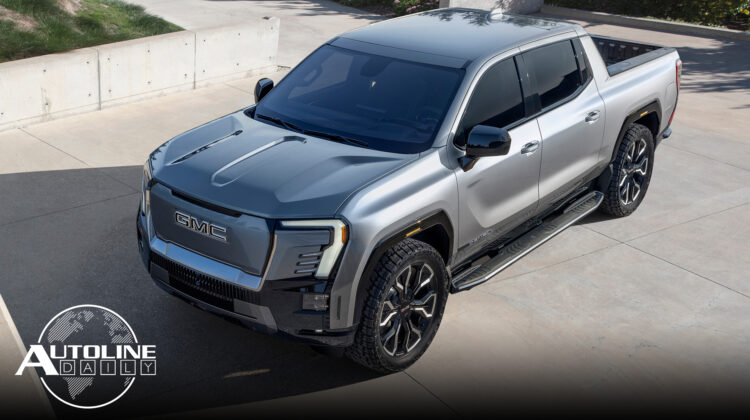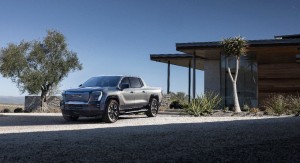
Listen to “AD #3432 – GMC Sierra EV Unveiled; Tesla Aims to Build 50,000 Semis; OEMs to Spend More Than $1 Trillion On EVs” on Spreaker.
Raise the bar on just how good car entertainment can sound. With greater details, clarity, and depth —Dolby Atmos is the future of car entertainment. Click here to learn more.
Follow us on social media:
Runtime: 10:13
0:08 CATL Re-Thinks North American Battery Plants
1:00 Automakers to Spend More Than $1 Trillion On EVs
1:59 Federal Agencies Boost EV Purchases
3:44 1st Edition GMC Sierra EV Carries Hefty Price Tag
5:29 Tesla Aims to Build 50,000 Semi Trucks Annually
6:58 Lane Markings Need Improvement for Autonomous Driving
8:07 Construction Equipment Promising Application for Electrification
Visit our sponsors to thank them for their support of Autoline Daily: Bridgestone, Dolby Atmos, Intrepid Control Systems, and Schaeffler.
This is Autoline Daily, the show dedicated to enthusiasts of the global automotive industry.
CATL RE-THINKS NORTH AMERICAN BATTERY PLANTS
Ever since the passage of the U.S. Inflation Reduction Act, there’s been a wave of foreign automakers making EV and battery production investments in the U.S., in order to qualify for EV tax incentives. But here’s a case of the opposite happening. Reuters reports that Chinese battery maker CATL is slowing its plans to open battery factories in the U.S. and Mexico because of concerns that the requirements for the sourcing battery materials will drive costs higher. The bill requires that 50% of the minerals used in EV batteries must be sourced in North America or other approved regions, which then rises to 80% by the end of 2026. As a result, CATL has slowed the vetting process for sites to open plants in North America and its decision is now in limbo.
AUTOMAKERS TO SPEND MORE THAN $1 TRILLION ON EVs
Automakers are making huge investments into EVs. Volkswagen is spending $100 billion by 2030. Toyota is spending $70 billion. But what would the figure be if you added it all together? According to Reuters, if you group up the top automakers, they’re going to spend a collective $1.2 trillion through the end of the decade. That includes sourcing the raw materials, making batteries and building the vehicles. The investment represents plans to build around 54 million BEVs by 2030, which would be about 50% of total vehicle production. But here’s the crazy part. Reuters did a similar analysis a year ago and this $1.2 trillion figure is more than double what it came up with in 2021. There’s been a lot more EVs announced since then and cost of materials has gone up exponentially.
FEDERAL AGENCIES BOOST EV PURCHASES
The Biden Administration is making good on its promise to increase the number of electrified vehicles in the federal government’s fleet. The White House revealed that 12% of light-duty vehicles that federal agencies purchased, or more than 3,500 total, in the 2022 budget year were BEVs or plug-in hybrids. If it weren’t for supply chain issues, the White House says it would have been 20% of purchases. If you go back, in 2021, agencies bought 33,000 vehicles but only 257 were BEVs or PHEVs, or just 1% of the total. The Biden Administration wants to end government purchases of ICE vehicles by 2035. But the Government Accountability Office or GAO says federal agencies need to significantly increase the number of chargers they own to reach that goal. As of March, the agencies own and operate 4,000 chargers but the GAO estimates it needs to increase that to 100,000.
1ST EDITION GMC SIERRA EV CARRIES HEFTY PRICE TAG
GMC revealed the all-electric version of the Sierra. In terms of technology, it’s not surprisingly different from the Chevy Silverado EV, but it is more so in the looks department, especially compared to the similarity of the ICE versions. We think that’s highlighted in three main areas. The front end of the Sierra EV is much busier than the electric Siverado, the GMC doesn’t have the same bed flare as the Silverado EV, which is reminiscent of the Chevy Avalanche and the interior layout is much different. It has a large, floating center display screen mounted in portrait mode that extends down to the center console, while there’s a single digital display for the driver embedded in the dash. The Denali Edition 1, which will be the first version of the truck to launch early in 2024, is the top-of-the-line and will have the most power. It’s going to have an estimated 754 horsepower, which means it will almost certainly have a 3-motor setup, will do 0-60 in an estimated 4.5 seconds and be able to tow up to 9,500 pounds. With an expected driving range of around 400 miles or 640 kilometers the Edition 1 will have the larger battery pack, which consists of 20 modules and around 205 kWh of space. The Edition 1 will carry a price tag of over $108,500, which includes destination but before any incentives. That’s a lot of money, but there will be other versions of the truck coming in 2025 with the base model starting around $51,000.
TESLA AIMS TO BUILD 50,000 SEMI TRUCKS ANNUALLY
Tesla could soon be one of the largest manufacturers of Class 8 semi-trucks in North America. Elon Musk said that it will take about a year to ramp up production, which has already started, but that it’s “tentatively aiming for 50,000 units in 2024 for Tesla Semi in North America.” He added that the Semi would be offered outside North America as well. The truck has an estimated 500 miles of range and uses Tesla’s older 2170 battery cells, presumably keeping the newer 4680 cells available for its passenger models.
LANE MARKINGS NEED IMPROVEMENT FOR AUTONOMOUS DRIVING
Interesting white paper we came across from VSI Labs. It did a deep dive into lane markings on roads and how they affect Lane Keep Assist and autonomous driving systems. It says lane markings are highly detectable by cameras, while radar does not get a return signal from them, and lidar can be iffy depending on the type of lidar being used. High def maps can be good but the licensing costs are high, and maintenance of the maps is challenging. Machine learning algorithms can accurately detect lane markings. But they can misinterpret them on ramps and blend areas as well as misinterpret expansion joints and cracks. That’s why it’s important to have the right kind of lane markings. VSI says lane marking should be at least 6” wide, and that there should be dotted line extensions along all entrance and exit ramps. It goes into a lot more detail about what’s needed and if you’d like to learn more, we’ve got a link to the white paper in the transcript or description box.
CONSTRUCTION EQUIPMENT PROMISING APPLICATION FOR EVs
We’ve reported on all kinds of electric vehicles, including cars, trucks, buses, and semis. But how about electric construction equipment? The AEM, which is the Association of Equipment Manufacturers, sent us an interesting report. It says compact construction equipment, like excavators smaller than 10 metric tons, are a promising application. Since they don’t have the high electric demand of cars or trucks, they can use much smaller battery packs. Unlike diesel powered excavators there’s no idling time, they only use power on demand. So, depending on the application, the electrics can provide up to 8 hours of work time. Doosan Bobcat even has a model that eliminates all the hydraulics and uses electric cylinders and drive motors instead, which is more efficient and requires less maintenance. Quite a few companies either have, or are coming out with electric construction equipment, like Volvo Construction Equipment, JCB, Doosan, which makes the Bobcat, as well as Green Machine, Moog Construction and WhisperDrive. We also have a link to that report in the transcript or description box if you’d like to learn more.
But that’s it for today, thanks for watching and have a great weekend.
Thanks to our partner for embedding Autoline Daily on its website: WardsAuto.com
Seamus and Sean McElroy cover the latest news in the automotive industry for Autoline Daily.






